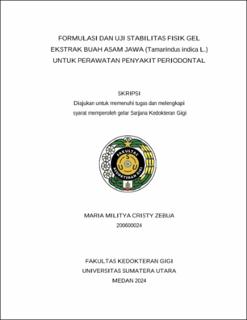| dc.description.abstract | Periodontal disease is a disease that involves the tissues supporting the teeth, namely the gingiva, periodontal ligament, cementum and alveolar bone. The initial mechanical treatment of periodontal disease is by treatment (scaling root planing) and curettage which can be combined with additional chemical therapy by administering antimicrobials, both locally and systemically. One of the local administration of antimicrobials is gel. Using herbal-based gels has many benefits and causes few side effects. Tamarind contains active biological components such as flavonoids, glycosides, saponins, and steroids/triterpenoids which function as antibacterials. Gel preparations produced from natural ingredients such as tamarind fruit must go through a testing stage to see their stability during use and long-term storage. The aim of this research is to formulate tamarind fruit extract (Tamarindus indica L.) in the form of a gel dosage form that meets the requirements for evaluating physical properties and analyzing the physical stability of the tamarind fruit extract gel preparation (Tamarindus indicaL.) with various formulations. This type of research is laboratory experimental research. The sample for this study was tamarind fruit extract gel (Tamarindus indicaL.). The tests carried out in this research were organoleptic tests, pH, viscosity, homogeneity, and evaluation of the physical stability of the gel preparation method cycling test in tamarind fruit extract (Tamarindus indicaL.) concentrations of 3.125%, 6.25% and 12.5%. The results of this research indicate that tamarind fruit extract can be formulated into a gel preparation that meets the physical property evaluation requirements. Tamarind fruit extract gel with a concentration of 3.125% has good stability in organoleptic tests, pH tests, homogeneity tests and viscosity tests. Tamarind fruit extract gel (Tamarindus indica L.) at concentrations of 6.25% and 12.5% did not have good stability in the pH test after the cycling test but remained stable in the organoleptic test, homogeneity test and viscosity test. The increase in gel concentration is directly proportional to the increase in viscosity and inversely proportional to the large pH. | en_US |


